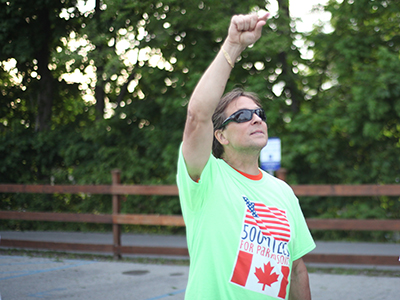
Former Krembil patient Harry McMurtry has led a team on foot 500 miles from New York to Toronto in support of raising awareness of Parkinson’s Disease. “Having a movement disorder means different challenges for different people. We do not see the world through the lens of disability,” he says. (Photo: 500 Miles for Parkinson’s)
There are many ways to get from New York to Toronto. Harry McMurtry decided to take the scenic route.
The 52-year-old former Krembil Neuroscience Centre patient set out on foot from the Big Apple last month on a 45-day trek to raise awareness and funding for the treatment of Parkinson’s Disease.
The neurodegenerative disease, which affects more than 100,000 Canadians, is characterized by slowness of movement, muscular rigidity and stiffness, tremors, and impaired balance.
Joining Harry on the 500 Miles for Parkinson’s walk is Dr. Ross Sugar of Baltimore, Maryland, and Sue Thompson of Toronto. All three have been diagnosed with Parkinson’s and hope to raise $500,000 to fight the disease. Proceeds will be pooled and divided among three beneficiaries, one of which is Toronto Western Hospital’s Morton and Gloria Shulman Movement Disorders Centre and The Edmond J. Safra Program in Parkinson’s Disease, which is led by Dr. Anthony Lang, Director of the Program.
Along the route, the group has staged dozens of rallies and events all while walking approximately 20 kilometres a day. The “final mile” will take place Monday on a route ending at Queen’s Park, and will include a rally with Ontario Premier Kathleen Wynne and Toronto Mayor John Tory. UHN staff are invited to show support by attending in person.
Harry took a small break from the road recently to discuss the walk with UHN News. Here’s what he had to say:
What inspired you to set off on this journey?
The need to take a bold step to raise money for Parkinson's research and to heighten awareness of the disease. The need to do something unique.
The walk started in New York and ends in Toronto. What is the significance of these two cities for you?
New York City is my current and future home. Toronto was my home for 40 of my first 50 years. These cities are the financial engines for the United States and Canada, respectively. They were ideal cities in which to ground this project.
How has the trip gone for you so far?
The trip has gone extremely well. We are accomplishing most, if not all, of our goals. We have also had a lot of fun!
What have been the milestones for you personally?
Being introduced in the New York State Senate, being recognized in the House of Commons (Canadian Parliament) and reaching the U.S.-Canada border.
Can you describe for us what an average day on the road is like for you?
Rising early - often too early. Having a bath with Epsom salts. Eating a healthy breakfast. Getting my feet and toes taped and oil applied to the rest of my feet to combat blisters. Getting on the road as early as possible, say, by 9 a.m. Walking 15 miles or sometimes less; consuming all my energy. Waiting for bedtime, having another bath with Epsom salts. Retiring between 8 and 9 p.m., utterly exhausted but happy.
What has the feedback and support been like for you out there?
Fabulous. All positive. People everywhere are supportive and appreciative of our efforts. One day, we stopped for lunch at Nirvana, a water bottling plant. Instead of just allowing us to find a little shade on their property, they filled our support vehicles with all the water that we could hold!
Part of the proceeds from the walk are going to Toronto Western Hospital’s Morton and Gloria Shulman Movement Disorders Centre and the Edmond J. Safra Program in Parkinson’s Disease. How did you come to know about these programs?
I was a patient at this clinic for eight years; Sue Thompson has been a patient there for the past three years. We have both received exceptional, world-class treatment there.
What would you like the public to know about what it is like to have a movement disorder?
The public needs to learn the symptoms of Parkinson’s to avoid stigmatizing people like me. I am not drunk and, no, I don't need to go to the hospital. Having a movement disorder means different challenges for different people, but it never justifies different treatment. We do not see the world through the lens of disability, nor do we want the public to view us this way or to identify us with the disorder.
Boxing legend Muhammad Ali died recently. How did he help bring attention to Parkinson’s Disease?
As the most famous person in the world, Muhammad Ali naturally brought much needed attention to Parkinson's disease. Michael J. Fox, who is almost as famous, placed the disease in the public consciousness and has done Herculean work to advance Parkinson’s research. We little people try to emulate their leadership, albeit on a much smaller scale.
What is the first thing you are planning to do when this is all over?
Hug my wife. Thank her for her extraordinary love and support. And then sleep.
Organizers of the 500 Miles for Parkinson’s walk plan to honour the efforts of Harry, Sue and Ross with an event at Steam Whistle brewery in Toronto on
Wednesday, June 22. Sportsnet television personality Caroline Cameron will host the event. Visit
www1.fivehundredmiles.org for details on buying tickets and making a donation.
